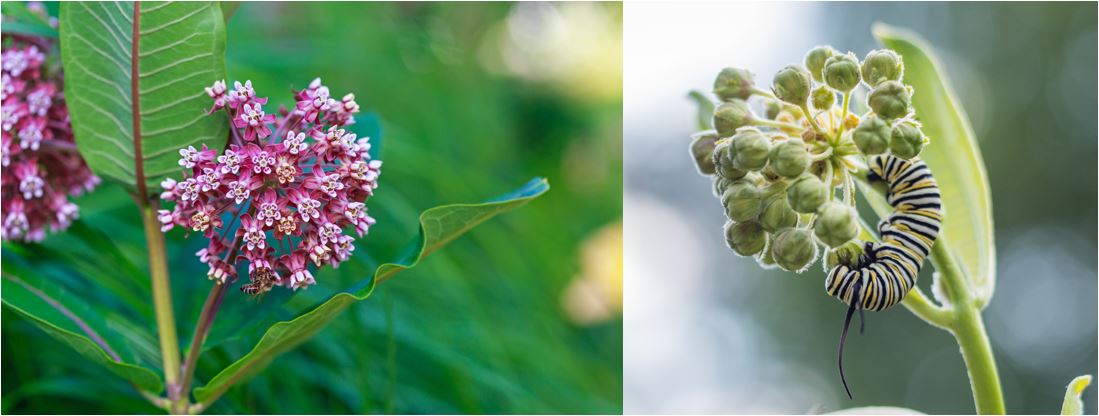4 Types of Milkweed in Oregon (AND One to Avoid!)
“What types of milkweed should I plant in my garden?”

This may seem like a crazy question if you’re just getting started with native gardening. Why would you want to plant a weed?!
But milkweed isn’t a weed at all. Instead, it’s a flowering plant that attracts butterflies (think Monarchs), native bees, and other pollinating insects, which is an excellent thing!
This article will give you information about common types of milkweed in your area and which ones will be best for your garden. And, keep reading to the end to learn about a kind of milkweed you want to avoid!
4 Types of Milkweed in Oregon:
#1. Showy Milkweed
- Asclepias speciosa

Growing Information:
- USDA Hardiness Zone: 3-8
- Life Cycle: Perennial
- Approximate Mature Size: 1.5 to 3 feet; occasionally up to 6 feet
- Bloom Time: May to September
As the name suggests, Showy Milkweed features flashy pink and white umbels or clusters of small flowers. The flowers are fragrant, and individual flowers look a bit like crowns. In ideal conditions, Showy Milkweed may grow as tall as 6 feet!

As a garden plant, Showy Milkweed has the benefit of being a less aggressive spreader than most other milkweed varieties in Oregon. It can be grown easily from seed or the cuttings of an existing plant. It’s very drought tolerant and can be grown in a wide range of soils.
Like other milkweeds, Showy Milkweed attracts native insects and Monarch Butterflies to your yard or garden. Monarchs will visit the flowers for nectar and lay eggs on the plants, which are host plants for the Monarch caterpillars. It will also attract beautiful Queen and Viceroy butterflies to your property!
#2. Narrowleaf Milkweed
- Asclepias fascicularis

Growing Information:
- USDA Hardiness Zone: 6-10
- Life Cycle: Perennial
- Approximate Mature Size: 1 to 3 feet
- Bloom Time: June to September
Narrowleaf Milkweed, sometimes called Mexican Whorled Milkweed in Oregon, is often seen growing in large groups. It has a much more delicate, grass-like appearance than Common Milkweed.
It’s most conspicuous when it’s in bloom, from June through September. The blooms are upright clusters of about 20 small flowers. The flowers are variable in color, from greenish to pink, white, and even purple. The thin, spiky leaves are arranged in a spiral around the stem. Beginning in July, seed pods replace the blooms. The seed pods are narrow, thin, smooth, and long. They split down the side and release wind-borne light brown seeds and coma when mature.
In the wild, Narrowleaf Milkweed is typically found in the dry climates of plains, foothills, valleys, and roadsides. In the garden, it can be started from seed and is a great low-maintenance plant. It thrives in areas with full sun and is drought-tolerant.
This species is a host plant for the caterpillars of Monarch and Queen Butterflies and Isabella Tiger, Clio Tiger, Hitched Arches, and Euchaetes Zella moths Various other pollinators like bumblebees and wasps also visit the plant’s blooms.
RELATED: 27 Rabbit Resistant Plants to grow in Oregon!
#3. Humboldt Mountain Milkweed
- Asclepias cryptoceras

In addition to Humboldt Mountain Milkweed, you may hear this species called Phallid Milkweed, Jewel Milkweed, Prostrate Milkweed, or Cow-Cabbage. Some of these names reflect its unusual appearance. 🙂
Humboldt Mountain Milkweed is a low-growing or drooping perennial with large, thick, heart-shaped, cabbage-like leaves. The flower clusters at the top of the stem look like jewels in the desert. Look for flowers that feature rose-colored hoods and white or yellowish-green petals that are bent downward. You may spot this plant blooming between April and June.
Humboldt Mountain Milkweed grows best in Oregon in areas with full sun and dry rocky or sandy soil. You can find it on talus slopes, roadsides, canyon bottoms, arid plains, and sandy and rocky washes.
#4. Heart-leaf Milkweed
- Asclepias cordifolia
As the name suggests, Heart-leaf Milkweed has large, heart-shaped leaves. The leaves are oppositely arranged and usually bluish-green in color. Like other milkweeds, splitting a leaf or stem will release a milky white sap.
Sometimes, you may hear Heart-leaf Milkweed called “Purple Milkweed.” This fitting name refers to the several clusters of dark red or purple flowers that form on two-year-old plants.
Native Americans managed and harvested this milkweed for its fiber to make rope and clothing. Archeologists found a 40-foot-long deer made from about 7,000 feet of Heart-leaf Milkweed that would have required harvesting over 35,000 plants!
Today, you can find Heart-leaf Milkweed growing in Oregon in dry, rocky areas in deserts, plains, woodlands, chaparral, and evergreen forests. It will grow in the mountains up to about 6,560 feet.
Tropical Milkweed
- Asclepias curassavica

Growing Information:
- USDA Hardiness Zone: 8-11
- Life Cycle: Perennial
- Approximate Mature Size: 3 to 4 feet
- Bloom Time: March to November in temperate climates, year-round in tropical climates.
This non-native milkweed plant has become popular in recent years because of its flowers’ bright red coloring and how easy it is to plant and maintain.
Unfortunately, Tropical Milkweed planted in Oregon may do more harm than good.
It carries a parasite of Monarch Butterflies called Ophryocystis elektroscirrha, or OE, which can cause defects in the wings of Monarchs. Since it doesn’t die back and can bloom late, the plant itself may also confuse Monarchs by signaling a breeding season when it’s time to migrate.
To ensure you’re planting milkweed that will help your local ecosystem and attract native pollinators, always choose a native species!
Marketers of Tropical Milkweed seeds will use the names Mexican Milkweed, Bloodflower, Mexican Butterfly Weed, Mexican Orange Milkweed, and Semi-Tropical Milkweed. Steer clear of all of these!
Are you looking for more information on milkweed in Oregon?
Check out this guide!
Do you have milkweed in your garden?
What’s your favorite thing about this plant? Leave a comment below!



